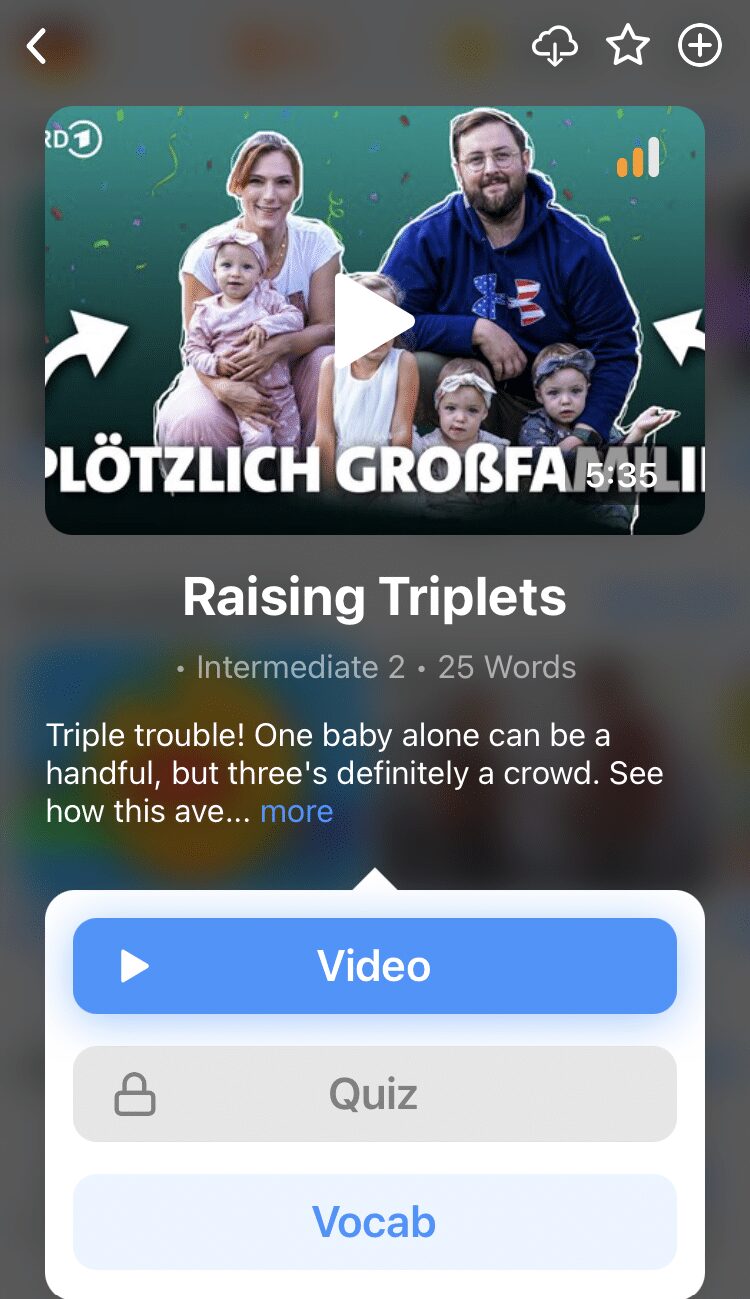Contents
- What Is the German Dative?
- German Dative Verbs
- German Dative Prepositions
- Mixed German Prepositions
- German Dative Definite Articles
- German Dative Indefinite Articles
- Sentence Structure with Dative Nouns and Pronouns
- Der Wemfall: Is That “Who” or “Whom”?
- How to Practice the German Dative
- And One More Thing...
The Dative Case in German

If you want to speak proper German, you have to really know your cases. German has four: nominative, accusative, genitive and dative (the case we’re focusing on today that most language learners come to fear).
Don’t worry, we’re going to make it as easy as possible for you.
Download: This blog post is available as a convenient and portable PDF that you can take anywhere. Click here to get a copy. (Download)
What Is the German Dative?
The dative’s main purpose is to point out the “indirect object”. That’s the person or thing that is receiving the “direct object”. For example:
Ich gebe der Frau einen Stift. (I give the woman a pen.)
In the above sentence, the “pen” is the thing being “given”, the action of the verb is being done to it. This makes it the direct object and so it goes in the accusative case.
The “woman” is receiving this direct object, making her the indirect object and putting her in the dative case.
One reason learners grapple with the German dative so much more than any other case is because it changes every definite and indefinite article.
In the example above, you’ll notice how die Frau has changed to der Frau. This is because the dative changes the feminine definite article from die to der.
If a sentence or clause is in the dative case, you need to make sure you’re using dative articles with nouns. As we don’t change articles in English, this can be tricky for learners to get their heads around.
It’s important to study these isolated examples, so we can learn the rules and understand how the dative works.
However, once you remember the following pattern of changes, you’ll find your understanding of German improves by leaps and bounds.
German Dative Verbs
Some German verbs always require the dative case—whether the following noun is the indirect object or not. Some notable ones are:
| to help | helfen |
| to thank | danken |
| to like | gefallen |
| to belong to | gehören |
| to match | passen |
| to taste | schmecken |
Here’s an example of how these verbs work:
Kannst du mir bitte helfen? (Can you please help me?)
In this instance, even though “me” is the direct object and would usually take the accusative, helfen forces it to be in the dative.
German Dative Prepositions
There is also a group of German prepositions that must be followed by the dative case. Try this handy version of “On the Beautiful Blue Danube” for remembering these prepositions:
| from/out/over | aus |
| except/besides | außer |
| with/by | bei |
| with | mit |
| after/to | nach |
| since | seit |
| from/of | von |
| to/too | zu |
Sie kommt aus der Turkei. (She comes from Turkey.)
Note: In German, Turkey (the country, not the bird!) translates as die Turkei—it always has a definite article.
Mixed German Prepositions
Here we have a group of prepositions that, just to confuse things, can take either the accusative or dative case. If there is no movement or change of state in the sentence, you’ll need to use the dative.
| on | an |
| on/upon | auf |
| behind | hinter |
| in/into | in |
| near/next to | neben |
| over/above | über |
| under | unter |
| in front of/before/to | vor |
| in between | zwischen |
So, for example:
Das Buch liegt auf dem Tisch. (The book is lying on the table.)
Ich lege das Buch auf den Tisch. (I lay the book onto the table.)
In the top sentence, the book is lying still on the table. There is no movement in the sentence, so auf triggers the dative case. Therefore, der Tisch changes to dem Tisch.
Whereas in the bottom sentence, the book is being moved onto the table. Der Tisch needs to change to den Tisch because the movement along with auf requires the accusative case.
To internalize these verbs and prepositions, you can see how the dative case is used in context on FluentU.
FluentU takes authentic videos—like music videos, movie trailers, news and inspiring talks—and turns them into personalized language learning lessons.
You can try FluentU for free for 2 weeks. Check out the website or download the iOS app or Android app.
P.S. Click here to take advantage of our current sale! (Expires at the end of this month.)
German Dative Definite Articles
| Article | Dative definite article | |
|---|---|---|
| Masculine | der | dem |
| Feminine | die | der |
| Neuter | das | dem |
| Plural | die | den + -n on end of noun |
Masculine Definite Article
In the dative case, instead of taking their usual der, masculine nouns need to use dem as their definite article.
Ich gebe dem Hund einen Ball. (I give the dog a ball.)
Ich zeige dem Mann den Ausweg. (I show the man the exit.)
Feminine Definite Article
We also need to change the feminine definite article. Der is used instead of die.
Er hat der Frau den Tisch verkauft. (He sold the table to the woman.)
Germans will often put the definite article before names in order to create a friendly, familiar feel. But you still need to respect the grammar rules:
Wir backen der Julia einen Kuchen. (We’re baking a cake for Julia.)
Neuter Definite Article
The definite article for neutral nouns, das, changes to dem. Just like the masculine one did!
Er gibt dem Pferd das Heu. (He gives the horse the hay.)
Don’t get caught out with the word das Mädchen. Despite describing a girl, this word is grammatically neuter!
Ich habe dem Mädchen einen Witz erzählt. (I told the girl a joke.)
Plural Definite Article
As well as changing the plural definite article to den, we also need to add an “-n” or “-en” ending to the plural noun. So, die Schüler (the pupils) goes to den Schülern in the dative:
Der Lehrer gibt den Schülern viele Hausaufgaben. (The teacher gives the pupils lots of homework.)
You don’t need to add anything if the plural form already ends on an -n, however, like die Eltern (the parents).
Ich habe den Eltern die Bilder gezeigt. (I showed the photos to the parents.)
German Dative Indefinite Articles
| Article | Dative indefinite article | |
|---|---|---|
| Masculine | ein | einem |
| Feminine | eine | einer |
| Neuter | ein | einem |
| Plural | keine | keinen |
Masculine Indefinite Article
It’s not just definite articles that are changed by the dative—indefinite ones get in on the action too! When it comes to masculine nouns, ein becomes einem.
Ich bin mit einem Freund ins Kino gegangen. (I went to the cinema with a friend.)
Bei einem Notfall rufen Sie die Polizei. (In an emergency, call the police.)
Feminine Indefinite Article
The pattern with indefinite articles follows that of the definite articles. So, die changes to der. That means eine will change to einer.
Sie hat einer Tante das Geld gegeben. (She gave the money to an aunt.)
Das habe ich in einer Zeitung gelesen. (I read that in a newspaper.)
Neuter Indefinite Article
Neuter nouns need einem instead of ein.
Ein Esel ist einem Pferd sehr ähnlich. (A donkey is very similar to a horse.)
Ich habe nichts außer einem Fenster gebrochen. (I didn’t break anything except a window.)
Kein
As in English, there is no indefinite article for plurals. However, we do use the article kein to negate plurals. In English, this is usually translated as “not a” or “not any.”
Wir arbeiten mit keinen Politikern zusammen. (We work with no politicians. / We don’t work with any politicians.)
Whereas in English, there are a few different constructions that get across the same idea, in German you’ll always be using kein.
Sentence Structure with Dative Nouns and Pronouns
Der Wemfall: Is That “Who” or “Whom”?
Even Germans find the dative hard to master! And for one reason in particular—its effect on the word wer (who). This aspect has even led to Germans coining the nickname der Wemfall for the dative.
Der Wemfall could be translated into English as “the whom-case.” Indeed, English used to have a dative case and “whom” is a remnant of this—but who really knows how to use “whom” correctly?
Germans sometimes have trouble remembering that wer is changed to wem in the dative, and that’s why they’ve come up with the nickname der Wemfall.
Whenever wer (who) is found in a dative clause, it changes to wem.
Wem hat er das Ticket gegeben? (To whom did he give the ticket?)
If you’re talking about people, check out our post on the dative pronouns in German.
How to Practice the German Dative
Getting exposure to the dative as it’s used in natural German speech is also important. Now that you’re done reading this post, you may wonder what the next step will be. Here are a couple of resources worth checking out.
Clozemaster focuses on helping you train your grammar skills through repetition. You can choose the specific grammar rule to focus on and practice it by typing in your own answer or choosing one.
You can also use Deutsche Welle to read more about the dative case or to listen to it being used in action through different audio and video series. The content is arranged by level, so you’ll hear this case used in situations that are easily understandable and level appropriate.
Hopefully, this article has given you all the weapons needed to tackle the dastardly dative case! Eventually, knowing all the cases will help you to better understand and speak German.
So time to get cracking on that dative!
Download: This blog post is available as a convenient and portable PDF that you can take anywhere. Click here to get a copy. (Download)
And One More Thing...
Want to know the key to learning German effectively?
It's using the right content and tools, like FluentU has to offer! Browse hundreds of videos, take endless quizzes and master the German language faster than you've ever imagine!
Watching a fun video, but having trouble understanding it? FluentU brings native videos within reach with interactive subtitles.
You can tap on any word to look it up instantly. Every definition has examples that have been written to help you understand how the word is used. If you see an interesting word you don't know, you can add it to a vocabulary list.
And FluentU isn't just for watching videos. It's a complete platform for learning. It's designed to effectively teach you all the vocabulary from any video. Swipe left or right to see more examples of the word you're on.
The best part is that FluentU keeps track of the vocabulary that you're learning, and gives you extra practice with difficult words. It'll even remind you when it’s time to review what you’ve learned.
Start using the FluentU website on your computer or tablet or, better yet, download the FluentU app from the iTunes or Google Play store. Click here to take advantage of our current sale! (Expires at the end of this month.)












